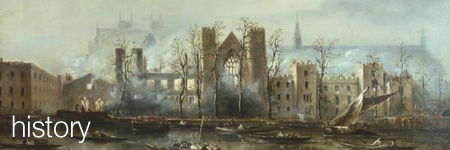
Smithfield
City (EC1) The origin of this name is unknown; some have derived it from smooth field. It is more probable that Smithfield was so called from the smiths who had their forges round about it when it first became, as it long continued, the great market for horses and other cattle. A part of Smithfield was known by the name of The Elms, from a number of those trees that grew on the spot. The Elms was the place of public execution until about the middle of the thirteenth century, when it was removed to Tyburn. It has been calculated that, during the short reign of Mary, two hundred and seventy-seven persons were burned to death in England for heresy, and of these the great majority suffered in Smithfield. Smithfield was the scene of the downfall of Wat Tyler. Here the daring rebel was struck to the ground by the weapon of Sir William Walworth. The dagger in the escutcheon of the City of London was introduced in commemoration of this event. (Reference: Smith's Streets of London, pp. 304, 305, 308)